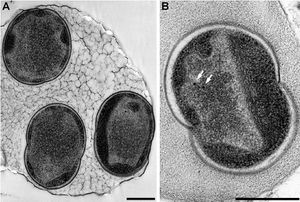Zoogloea
Classification
Domain: Bactria Phylum: Proteobacteria Class: Betaproteobacteria Order: Rhodocycales Genus: Zoogloea Species: Ramigera
Description
Zoogloea can be found free-living in fresh waters that have been organically polluted. It can also grow in waste-water treatment at all levels. Zoogloea are aerobic, chemoorganotrophic. For energy they use oxidative metabolism. Zoogloea has been studied as a pure culture. Zoogloea range range in size between 0.5 um to 1.3. They are normally a rod-shape with flagellum.
Ecology and Significance
This microbe was discovered in 1868. It 's first names species was Zoogloea ramigera. The name Zoogloea comes from the Greek language and when translated to English it means "living glue." This may be because of it's ability to attract nutrients from water. This species is stable at pH levels of 3-10 and temperatures on 15-90 degrees Celsius.
Genome Structure
G/C is roughly 64.5%
Metabolism
Zoogloea plays an important role in waste-water treatment because it is capable of lowering demand for biological oxygen. It also has the capable of enhancing the formation of sludge. The activated sludge bacterium that create habitats for activated sludge flocs. It has been studied that high amounts of Zoogloea ramigera normally correlates with overloading sewage plants. The flocs that form settle at the bottom of the water-waste treatment tank and help the purification process. This species also plays a role in poly-B-hydroxybutyrate (PHB) production and biosorption of metals.
Interaction with Other Organisms
PHB is produced whenever both a carbon source is highly present as well as B-ketothiolase. Biological Oxygen Demand (BOD) is reduced by Z. ramigera. The species is also known to use Mn-oxidation metabolism, because the matrix made by Zoogloea takes in and concentrated metal in water sources.
References
[1] Golyshin, Peter N. “Genome Sequence Completed of Alcanivorax borkumensis, a Hydrocarbon-degrading Bacterium That Plays a Global Role in Oil Removal from Marine Systems.” 3 (2003): 215-20. Print.
http://web.mst.edu/~microbio/BIO221_2001/zoogloea_ramigera.html
http://web.mst.edu/~microbio/BIO221_2001/zoogloea_ramigera.html
Figures
[1F]
[1] [2F] [2] [3F] [3] [4F] [4] [5F] [Original Figure. Author: Pawan Dhaliwal] [6F]
http://microbewiki.kenyon.edu/index.php/File:Lorenzo.gif
[7F] [5]
Author
Page authored by Rachel Rodriguez, student of Prof. Katherine Mcmahon at University of Wisconsin - Madison.

